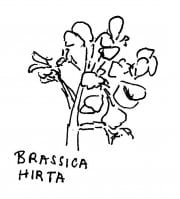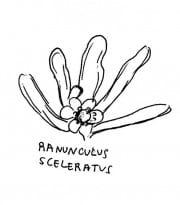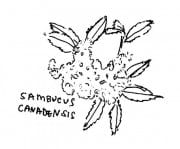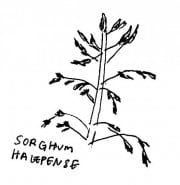Glycoside is a chemical found in some plants that makes them poisonous. Glycoside works to stop vital organs, such as the heart or thyroid. Listed are 17 plants in Missouri which contain glycoside and have adverse effects on humans. More information on the poisonous and non-poisonous parts of the plant can be found here. This information gives a broad, not comprehensive, idea of which poisonous glycoside plants exist in Missouri.
A note about scientific names: the non-italicized L. after the Latin species name stands for Linnaeus, who was the person who named the plant, as with Moench and Willd. When there is a non-italicized abbreviation in parentheses, such as (L.) or (Ait.), it is referring to the person who first named the plant, but had named it something else. The updated name of the plant, the species name used now, is attributed to the name not in parentheses, such as Pers. or Lam.
 Actaea rubra (Ait.) Willd. // Red baneberry
Actaea rubra (Ait.) Willd. // Red baneberry
- Herbaceous perennial of 50-70cm in height emerging from thick roots
- Toxins in all parts of plant
- Causes stomach cramps, headaches, dizziness, vomiting, diarrhea, and circulatory (heart) failure
 Aesculus glabra Willd. // Buckeye
Aesculus glabra Willd. // Buckeye
- Small tree of 3-8m in height with opposite, palmately compound leaves that are dark green and glossy
- Toxins found in young sprouts, leaves, flowers, and seeds
- Causes weakness, muscle twitching, lack of coordination, depression, diarrhea, vomiting, dilated pupils, paralysis, stupor, and inflammation of mucous membranes
 Agrostemma githago L. // Corn cockle
Agrostemma githago L. // Corn cockle
- Herbaceous annual weed 40-75cm in height with hairy stem and opposite leaves
- Toxins found in seeds
- Causes abdominal pain, vomiting, dizziness, diarrhea, rapid breathing, and coma
 Brassica hirta Moench // White mustard
Brassica hirta Moench // White mustard
- Herbaceous annual that is bristly and hairy throughout and grows 20-60cm high
- Toxins found in all parts of plant
- Causes stomach flu, mouth irritation, salivation, diarrhea, difficult breathing, and, sometimes, paralysis of the heart and lungs
 Convallaria majalis L. // Lily of the valley
Convallaria majalis L. // Lily of the valley
- Herbaceous (having little to no woody tissue, stems are green and soft) perennial (occurring every year) that is 15-25cm tall and has thick roots and a deep root system
- Toxins found in all parts of plant
- Causes irregular heartbeat and stomach trouble
 Digitalis purpurea L. // Foxglove
Digitalis purpurea L. // Foxglove
- Herbaceous perennial or biennial (occurring every two years) that is 1.0-1.5 meters tall with alternate, densely hairy leaves
- Toxins found in all parts of plant
- Causes stomach disorders, diarrhea, headaches, irregular heartbeat, drowsiness, tremors, and convulsions (sudden movement)
 Linum usitatissimum L. // Flax
Linum usitatissimum L. // Flax
- Herbaceous annual (occurs for one year) that reaches 60-100cm tall with alternate leaves
- Toxins found in leaves
- Causes rapid and difficult breathing, gasping, staggering, paralysis, coma, and death
 Melilotus officinalis (L.) Lam. // Sweetclover
Melilotus officinalis (L.) Lam. // Sweetclover
- Herbaceous biennial 1.0-1.5m tall with compound leaves formed of 3 leaflets
- Toxins found in all parts of plant
- Causes internal bleeding, pockets of blood under skin, strong heartbeat, and low body temperature
 Nerium oleander L. // Oleander
Nerium oleander L. // Oleander
- Shrub grown indoors and outdoors that can reach 4m tall and has pink or white flowers
- Toxins found in all parts of plant
- Causes depression, vomiting, gastroenteritis, increased heart rate, dizziness, bloody feces, and paralysis of respiratory muscles; death occurs in one day
 Phytolacca americana L. // Pokeweed
Phytolacca americana L. // Pokeweed
- Herbaceous perennial 1.5-2.5m tall with white flowers tinged in purple
- Toxins found in all parts of plant, but roots are most poisonous
- Causes gastric-intestinal pain, spasms, ulcerative gastritis (inflamed stomach lining causing ulcers, or deep sores), vomiting, diarrhea, and convulsions
 Prunus virginiana L. // Chokecherry
Prunus virginiana L. // Chokecherry
- Woody perennial of 20-50cm in height with branches of purplish color and simple alternate leaves
- Toxins found in bark, leaves, and seeds
- Causes difficult breathing, throat paralysis, spasms, and coma
 Ranunculus sceleratus L. // Cursed buttercup
Ranunculus sceleratus L. // Cursed buttercup
- Herbaceous annual of 20-50cm in height with yellow flowers
- Toxins found in all parts above the ground
- Causes salivation, gastric pains, loss of appetite, colic, diarrhea, and slowing of heartbeat
 Sambucus canadensis L. // Elderberry
Sambucus canadensis L. // Elderberry
- Coarse, woody shrub 2-3 high with branches near the top
- Toxins in foliage, stems, roots, and berries; cooking destroys the poison
- Causes nausea, vomiting, diarrhea, and gastrointestinal pains
 Saponaria officinalis L. // Soapwort
Saponaria officinalis L. // Soapwort
- Herbaceous perennial growing 30-80cm high with opposite leaves and pink or white flowers
- Toxins found in seeds
- Causes nausea, vomiting, diarrhea, unsteadiness, irritation of digestive system, rapid breathing, and coma
 Sorghum halepense (L.) Pers. // Johnson grass
Sorghum halepense (L.) Pers. // Johnson grass
- Herbaceous perennial grass that reaches 1.0-2.5m tall with tangled roots
- Toxins found in all parts of plant; young or second growth plants especially dangerous
- Causes salivation, difficult breathing, dizziness, rapid pulse, coma, spasms, and lack of coordination
 Thlaspi arvense L. // Pennycress
Thlaspi arvense L. // Pennycress
- Herbaceous annual which grows to be 30-60cm high and has alternate leaves
- Toxins found in seeds
- Causes gastric distress, diarrhea with bloody feces, colic (abdominal pain), and, in extreme cases, paralysis of the heart and respiratory system
 Triglochin maritimum L. // Arrowgrass
Triglochin maritimum L. // Arrowgrass
- Herbaceous perennial with all leaves sprouting from the base; 20-40cm tall
- Toxins found in all parts of plant
- Causes difficult breathing, twitching, trembling, spasms, and death
Click here to view field card
Sources
Nomenclature, Names, and Taxonomy. Retrieved from http://herbarium.usu.edu/teaching/4420/botnom.htm
Stephens, H.A. (1980) Poisonous Plants of the Central United States. Lawrence, Kansas: University Press of Kansas.
All illustrations are original works of Ayana Arrington.